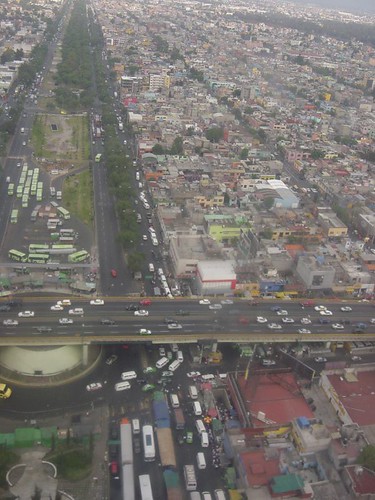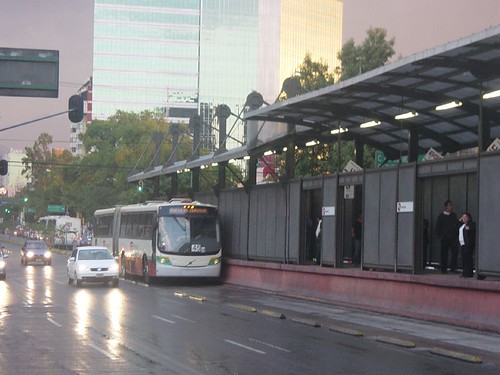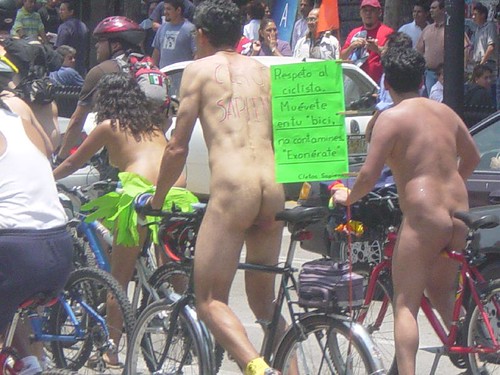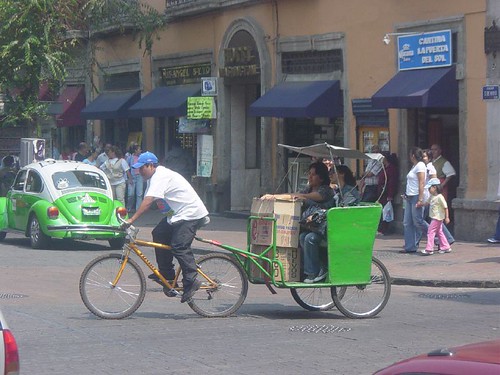I am grateful to Bernardo Baranda (formerly with the Center for Sustainable Transport Mexico (Centro de Transporte Sustenable, and now Mexico country director with ITDP) for helping me learn more about the transport scene in Mexico City.
 As I flew in I was struck by the grid layout and that the city was low-rise (rarely more than 2 or 3 storeys) mostly. Also impressive was the sheer scale of the place (around 20 million in the metropolitan area I was told) and the bright colours of many houses. This was my first time anywhere in Latin America so I couldn't help but make comparisons and contrasts with Asian middle-income and low-income cities that I am more familiar with.
As I flew in I was struck by the grid layout and that the city was low-rise (rarely more than 2 or 3 storeys) mostly. Also impressive was the sheer scale of the place (around 20 million in the metropolitan area I was told) and the bright colours of many houses. This was my first time anywhere in Latin America so I couldn't help but make comparisons and contrasts with Asian middle-income and low-income cities that I am more familiar with.Here are a few transport-related impressions that I jotted down along the way.
The large number of street stalls and hawkers surprised me, especially near Metro stations, possibly more even than in Bangkok or Jakarta... And more tolerance of them apparently.
The Metro has rubber tyred wheels, is very frequent, very extensive, mostly crowded, and much cleaner than books had made me expect.
Most housing and buildings tend to front onto the street even in outer areas. I didn't see any really suburban looking places. However, I did find a few US-style strip mall areas, complete with Wal-Mart (although I was pleased to notice that its car parking was not free).
The historic centre has a rather European look and feel to me, certainly much more so that I am familiar with in Southeast Asia, where local and Chinese styles are just as prominent
I was impressed by the quality of public spaces, especially the many squares (plazas), which are very well used and lively. It is hard to find such wonderful public spaces in Southeast Asia. And despite various dire warnings about crime and personal security, I never felt threatened.
Public transport is incredibly cheap. For example tickets to the Metro are per entry 2 pesos per entry (unlimited distance). Two pesos is just under 20 US cents.
Minibuses ('peseros') are ubiquitous and appear to fill a real need as feeder services to metro as well as for longer rides to some extent. They have been steadily increasing in numbers, causing some concern to some.
 The metrobus busway seems successful. Actually another city, Leon, was first to build BRT in Mexico. Leon is apparently lucky to have an institute for urban policy (or something like that) that does very good planning; their busways have been done very well at relatively low cost. Bernardo reports that it is estimated that Mexico City's Insugentes busway is carrying about 250,000 per day with just 80 buses, a little more than the 220,000 or so who were carried before by hundreds of Peseros, and ordinary buses. (BTW the newly elected Mayor of Mexico City has recently announced plans for several more busway corridors). Read more about Metrobus's early success here. It is also estimated that 5% of busway users were not public transport users before, so some success in making public transport attractive to richer groups. This particular corridor is a rather upmarket one in general. By contrast, the Metro apparently has a poor image with many of the middle and higher income groups, for being crowded and difficult to access with vendors crowd all approaches.
The metrobus busway seems successful. Actually another city, Leon, was first to build BRT in Mexico. Leon is apparently lucky to have an institute for urban policy (or something like that) that does very good planning; their busways have been done very well at relatively low cost. Bernardo reports that it is estimated that Mexico City's Insugentes busway is carrying about 250,000 per day with just 80 buses, a little more than the 220,000 or so who were carried before by hundreds of Peseros, and ordinary buses. (BTW the newly elected Mayor of Mexico City has recently announced plans for several more busway corridors). Read more about Metrobus's early success here. It is also estimated that 5% of busway users were not public transport users before, so some success in making public transport attractive to richer groups. This particular corridor is a rather upmarket one in general. By contrast, the Metro apparently has a poor image with many of the middle and higher income groups, for being crowded and difficult to access with vendors crowd all approaches.I didn't witness much serious congestion. Maybe I was never at the right places at the right times. Nevertheless, this surprised me having heard so many stories about legendary Mexico City traffic jams.
The pedestrian environment was generally good I thought. Certainly not as bad as I had thought it would be and much better than in many Southeast Asian cities.
 Efforts to help bicycle users are in their early stages, but there are already a few bicycle ways. The efforts so far are being strongly encouraged by a vocal and enthusiastic group of bicycle activists as well as the CTS ('Centro de Transporte Sustenable'). By chance I witnessed one of the bicycle activist events - a NUDE bike ride, which had more than 100 riders. The Sunday crowds in the historical centre gaped at the extraordinary sight. A very successful event in that it got huge press coverage (including TV news and front page of several papers) despite competing with the fierce election season and the football World Cup! And no, I did NOT participate myself.
Efforts to help bicycle users are in their early stages, but there are already a few bicycle ways. The efforts so far are being strongly encouraged by a vocal and enthusiastic group of bicycle activists as well as the CTS ('Centro de Transporte Sustenable'). By chance I witnessed one of the bicycle activist events - a NUDE bike ride, which had more than 100 riders. The Sunday crowds in the historical centre gaped at the extraordinary sight. A very successful event in that it got huge press coverage (including TV news and front page of several papers) despite competing with the fierce election season and the football World Cup! And no, I did NOT participate myself.I also saw quite a number of pedicabs, using mountain bikes fitted with trailers. Quite nifty really. Most of the ones I saw were in and around the historic centre, near the Zocalo. But also
 saw one or two working in the outer suburbs in poor neighbourhoods. As the nude bike rally (mentioned above) was passing by I happened to be standing beside a pedicab driver. With my rather poor Spanish I managed to ask him why HE had his clothes on. Luckily for me he did not take offence. Just laughed and said they are all loco! Loco!
saw one or two working in the outer suburbs in poor neighbourhoods. As the nude bike rally (mentioned above) was passing by I happened to be standing beside a pedicab driver. With my rather poor Spanish I managed to ask him why HE had his clothes on. Luckily for me he did not take offence. Just laughed and said they are all loco! Loco!If you want to read more about Mexico City try here and for more on its urban transport issues in Mexico City you could start here (pdf).

1 comment:
Hi Paul:
I am interested by the bike section, but not the nude part :)
Currently I am staying in Kyoto. And way different from Malaysia, I start to cycle instead of driving. I think what make me accept this cycling lifestyle include: nice weather here (seasonal vs hot/humid in Malaysia), excellent cycling road/path, relatively flat topography, and reasonable travel distance. Do you think are these prerequisites valid before a city can promote bicycling to reduce traffic congestion? The reason I brought up this is because I don't have good feeling if Kuala Lumpur or Singapore to adopt bicycling for the very first reason I mentioned: weather!
Post a Comment